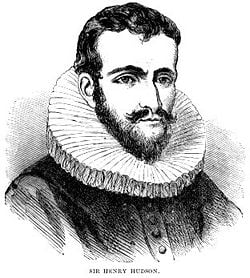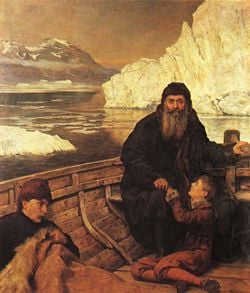Who Was Sent Adrift and Never Was Seen Again

"No portrait of Hudson is known to be in being. What has passed with the uncritical for his portrait—a dapper-looking man wearing a ruffed collar—frequently has been, and continues to be, reproduced. Who that man was is unknown. That he was not Hudson is certain." Thomas A. Janvier, biographer of Henry Hudson. The analogy featured here comes from the (presumably uncritical) Cyclopaedia of Universal History, 1885.
Henry Hudson (September 12, 1570s – 1611) was an English sea explorer and navigator in the early seventeenth century. He was built-in in London, England, and he presumably died in 1611 in Hudson Bay, Canada after his mutinous crew left him there. Hudson's daring, albeit short, career as an explorer of the New World earned him a place in history every bit 1 of the almost important European explorers of Northward America
Hudson's explorations of the chill regions exemplify the relentless human quest to understand and master the environs. Facing extraordinary physical hardships, Hudson and his crew navigated through unknown regions in search of a commercial sea route to the Indies. Yet his greatest antagonist proved to be not the harsh arctic elements only his own crew. Lacking empathy and abandoning their obligations equally subordinates to the ship's helm, the mutineers dispatched Hudson, his teenage son, and loyal coiffure members to almost certain death in the arctic wastelands.
Contents
- i Early on Life
- 2 Voyages
- 2.one Final Voyage
- iii Significance and Legacy
- 4 Notes
- five References
- 6 External Links
- vii Credits
Significantly, Hudson'southward exploration of the Hudson River led to Dutch colonial claims on the region and the institution of the colony of New Amsterdam, afterwards renamed New York post-obit British defeat of the Dutch.
Early Life
Because Hudson appears first in written records in 1607, much of Hudson's early life is an unknown. Because his eventual position as ship's captain, yet, he likely spent many of those early years at body of water. He probably started as a cabin male child and gradually worked his mode up to the rank of helm. Historians know that Hudson was married to a adult female named Katherine because she petitioned the British East India Visitor to ship a ship to await for Hudson iii years subsequently his disappearance. Subsequently it became articulate that Hudson was not coming back, Katherine appealed to the company for financial compensation, which she eventually received.[ane]
Hudson had three sons—Richard, John, and Oliver. John served equally a send'due south boy on all four of his begetter's voyages, and the mutinous crew left him to die equally well.[two]
Voyages
Henry Hudson captained four dissever, recorded voyages to the New World between 1607 and 1610, all of which took him into the treacherous—and then mostly unfamiliar—waters of the Chill Bounding main.[3]
In 1607, the Muscovy Company of England hired Hudson to find a Northeast Passage to Cathay. On his vessel Hopewell, Hudson traveled just 577 nautical miles south of the North Pole and discovered what is now known as Jan Mayen Island earlier turning around and returning home in September. January Mayen Island later became part of the Kingdom of norway.
In 1608, once again in the service of the Muscovy Company and on the Hopewell, Hudson made a second attempt to observe a Northeast Passage. Ice-laden waters forced him to turn back, however, and a reluctant coiffure scuttled his hopes to search instead for a Northwest Passage. [iv] Hudson'due south lack of success in reaping any financial proceeds or meaningful discoveries from his get-go ii voyages convinced the Muscovy Co. to surrender on funding further expeditions.
In 1609, the Dutch East India Company chose Hudson to atomic number 82 an trek to observe an easterly passage to Asia. He was told to sail through the Arctic Bounding main northward of Russia, into the Pacific, and so to the Far East. Once once more, Hudson could not continue his voyage due to the ice that had plagued his previous voyages, and many others before him. Having heard rumors by way of Jamestown and John Smith, he and his crew decided to effort to seek out a Southwest Passage through N America.
After crossing the Atlantic Ocean, the Half Moon sailed briefly in the Chesapeake Bay and Delaware Bay, but Hudson concluded that these waterways did not lead to the Pacific Ocean. Hudson then moved into New York Harbor and proceeded upwardly what is today the Hudson River. He made it equally far as present-day Albany, New York, where the river narrows, before he was forced to turn around, realizing that it was non the Southwest Passage. In fact, no Southwest Passage to the Pacific existed until one was created past the construction of the Panama Canal between 1903 and 1914.
Along the style Hudson traded with numerous Native American tribes and obtained different seashells, beads and furs. His voyage established Dutch claims to the region and the fur trade that prospered there. New Amsterdam in present-24-hour interval Manhattan became the capital letter of New Netherlands in 1625.
Final Voyage
In 1610, Hudson obtained the financial bankroll for yet another voyage, now nether the English flag. For this voyage, the Virginia and British East Bharat Companies provided the funding. At the helm of his new ship, the Discovery, he charted a northerly course (some claim that he had deliberately sailed too far south during his voyage for the Dutch), reaching Iceland on May 11 and the south of Greenland on June 4.
At that point, the coiffure began to think that the send had finally institute a Northwest Passage through the continent. On June 25th, the explorers reached the Hudson Strait at the northern tip of Labrador. Following the southern coast of the strait on Baronial 2, 1610 the ship entered Hudson Bay. Hudson spent the post-obit months mapping and exploring the eastern shores. In November, however, the ship became trapped in the frozen waters of James Bay, forcing the crew to move aground for the winter.

John Collier's painting of Henry Hudson with his son and some crew members after a wildcat on his icebound ship. The boat was set up adrift and never heard from again.
When the ice cleared in the spring of 1611, Hudson planned to continue exploring. His crew was disenchanted by that point, yet, and wanted to return home. Assertive that Hudson had pushed them as well far, the crew mutinied in June, 1611. They gear up Hudson, his teenage son John, and seven crewmen loyal to Hudson adrift in a small open boat. The mutinous crew provided the castaways with no nutrient, water or weapons. Clearly, they intended for Hudson and his companions to die. Hudson was never seen over again, although some claim that he successfully made his way as far south as the Ottawa River. Merely eight of the mutinous crewmen survived to return to Europe, and although arrested, none were punished for the mutiny and Hudson's death.
Significance and Legacy
Henry Hudson never discovered a Northwest Passage across the Canadian expanse or a Northeast Passage north of Russia, but he did brand many important contributions to European navigation and exploration. On his kickoff voyage, for example, Hudson discovered and fabricated note of whale pods off the coast of Spitzbergen Isle (today a possession of Kingdom of norway). England later made commercial use of this discovery, declaring Hudson the "granddaddy of the English whaling industry."[5]
More importantly, Henry Hudson made crucial discoveries on his voyages to the New World. On his third recorded voyage, Hudson explored the area around present-day New York Metropolis, including the river that now bears his name. On his fourth and final voyage, Hudson explored what is known today every bit Hudson Bay in Canada. Henry Hudson's discoveries prepared the way for the development of Dutch colonies in present-day New York and the fur merchandise that developed in the region later on. For these achievements, he is ane of the most significant of the early on European sailors who explored the New World and is the namesake not only of the river and bay, but of the city of Hudson, New York, New York City's Henry Hudson Parkway, and many other memorials.
Notes
- ↑ "Hudson's Background and Early Years," IanChadwick.com. Hudson's Background and Early Years Retrieved August 1, 2007.
- ↑ ibid
- ↑ ibid
- ↑ ibid
- ↑ Henry Hudson's First Voyage Retrieved Baronial 1, 2007.
References
ISBN links support NWE through referral fees
- Samuel. Henry Hudson's Voyages, from Purchas His Pilgrimes. March of America facsimile series, no. 19. Ann Arbor [Mich.]: University Microfilms, 1966.
- Sandler, Corey. Henry Hudson: Dreams and Obsession. New York, NY: Citadel Press, 2007 ISBN 0806527390
- Tomalin, Ruth. W.H. Hudson: A Biography. London: Faber and Faber, 1982 ISBN 9780571105991
External Links
All links retrieved Dec sixteen, 2017.
- Data about Hudson's life and voyages
- Biography at the Dictionary of Canadian Biography Online
- Henry Hudson - A Brief Statement Of His Aims And His Achievements past Thomas A. Janvier, at Project Gutenberg.
- Historic Hudson River Towns
- Henry Hudson biography folio
Credits
New Globe Encyclopedia writers and editors rewrote and completed the Wikipedia article in accordance with New Globe Encyclopedia standards. This commodity abides past terms of the Creative Commons CC-by-sa 3.0 License (CC-by-sa), which may exist used and disseminated with proper attribution. Credit is due under the terms of this license that can reference both the New World Encyclopedia contributors and the selfless volunteer contributors of the Wikimedia Foundation. To cite this commodity click hither for a listing of acceptable citing formats.The history of earlier contributions by wikipedians is accessible to researchers here:
- Henry Hudson history
The history of this article since it was imported to New World Encyclopedia:
- History of "Henry Hudson"
Annotation: Some restrictions may apply to use of individual images which are separately licensed.
Source: https://www.newworldencyclopedia.org/entry/Henry_Hudson
0 Response to "Who Was Sent Adrift and Never Was Seen Again"
Post a Comment